Impact Mapping Strategic Planning Technique
27 December 2018
Follow @scottgraffius
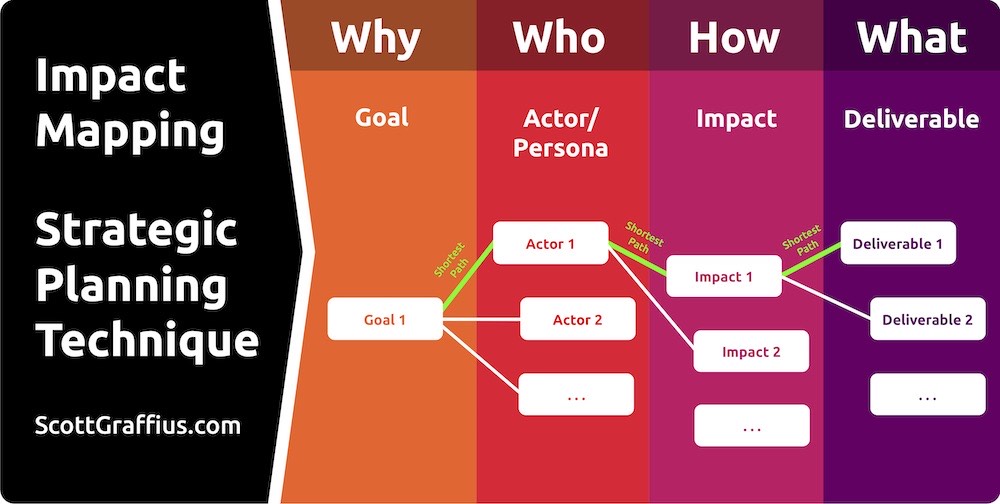
Impact mapping—introduced by Gojko Adzic—is a collaborative and visual strategic planning technique for business. This article provides a concise overview of the process, and it includes real-world examples. Four major steps follow. For simplicity, most examples are listed in the singular (such as one goal). However, multiples (such as several goals) may be used.
Step 1: Answer “Why?”
First the goal is established. The focus should be on important strategic objectives—which may include increasing revenue, decreasing costs, product development, or other categories. To ensure a clear shared understanding, it is suggested that the goal is SMART: specific, measurable, achievable, relevant, and time-bound. This example is not SMART: “Increase revenue.” But this version is SMART: “Increase revenue by 10% over the next 30 days.”
Step 2: Answer “Who?”
Next, the people who can help (or be a hinderance) in achieving the goal are identified. Such people may be referred to as actors or personas. Actors are someone or something that “acts” on or with the system—such as a customer. Personas are fictitious characters that represent user types—such as Developer Dave. It is suggested that the people are as specific as possible. For the goal of “Increase revenue by 10% over the next 30 days,” examples of Who include (a) Existing Customer and (b) Prospective Customer.
Step 3: Answer “How?”
In this step, the impacts that need to be had on the actors/personas—for them to help achieve the goal (or minimize/avoid them being a hinderance)—are identified. Continuing on the example from steps 1-2, an impact for the Existing Customer is to (a) refer more friends and (b) have a larger order dollar value.
Step 4: Answer “What?”
The deliverable which is hoped to create the impact on the actors/personas to achieve the goal is identified in this step. Said differently, What is the deliverable related to the How in the prior step. Continuing on the example from steps 1-3, deliverables for Refer More Friends include (a) discount code and (b) referral bounty.
Recap and Putting the Results to Use
The impact map is a visual artifact, developed collaboratively while answering the four questions: “Why (Goal)?,” “Who (Actor/Persona)?,” “How (Impact)?,” and “What (Deliverable)?” The exercise may reveal considerable items for consideration. Everything does not need to be implemented, however. It is suggested that the entries are prioritized (such as determining the shortest path) and that the most important work is done.
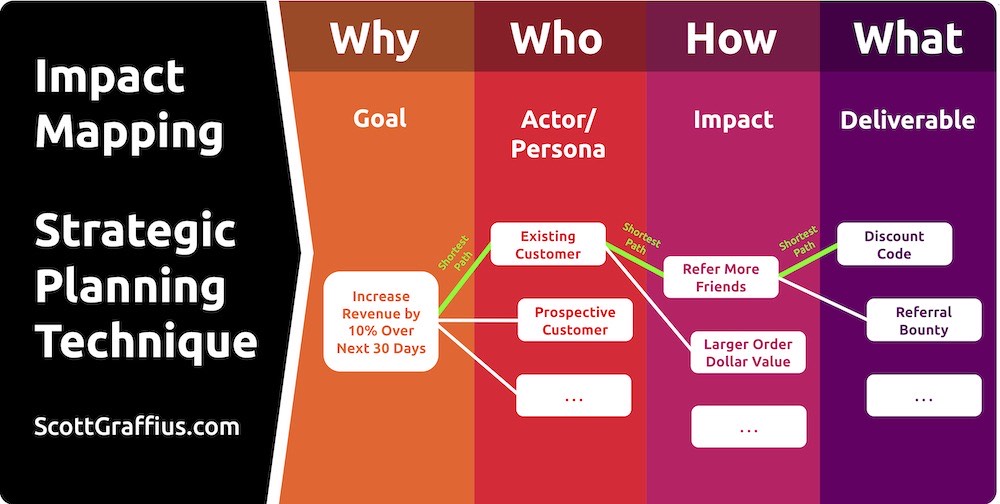
The illustration above incorporates some of the examples from this article. As shown, the shortest path involves providing a discount code related to existing customers referring more friends. In this case, that’s the work that should be done (at least done first).


© Copyright 2018 Scott M. Graffius. All rights reserved. This material may not be published, broadcast, rewritten or redistributed without the express written permission of Scott M. Graffius.


Impact mapping—introduced by Gojko Adzic—is a collaborative and visual strategic planning technique for business. This article provides a concise overview of the process, and it includes real-world examples. Four major steps follow. For simplicity, most examples are listed in the singular (such as one goal). However, multiples (such as several goals) may be used.
Step 1: Answer “Why?”
First the goal is established. The focus should be on important strategic objectives—which may include increasing revenue, decreasing costs, product development, or other categories. To ensure a clear shared understanding, it is suggested that the goal is SMART: specific, measurable, achievable, relevant, and time-bound. This example is not SMART: “Increase revenue.” But this version is SMART: “Increase revenue by 10% over the next 30 days.”
Step 2: Answer “Who?”
Next, the people who can help (or be a hinderance) in achieving the goal are identified. Such people may be referred to as actors or personas. Actors are someone or something that “acts” on or with the system—such as a customer. Personas are fictitious characters that represent user types—such as Developer Dave. It is suggested that the people are as specific as possible. For the goal of “Increase revenue by 10% over the next 30 days,” examples of Who include (a) Existing Customer and (b) Prospective Customer.
Step 3: Answer “How?”
In this step, the impacts that need to be had on the actors/personas—for them to help achieve the goal (or minimize/avoid them being a hinderance)—are identified. Continuing on the example from steps 1-2, an impact for the Existing Customer is to (a) refer more friends and (b) have a larger order dollar value.
Step 4: Answer “What?”
The deliverable which is hoped to create the impact on the actors/personas to achieve the goal is identified in this step. Said differently, What is the deliverable related to the How in the prior step. Continuing on the example from steps 1-3, deliverables for Refer More Friends include (a) discount code and (b) referral bounty.
Recap and Putting the Results to Use
The impact map is a visual artifact, developed collaboratively while answering the four questions: “Why (Goal)?,” “Who (Actor/Persona)?,” “How (Impact)?,” and “What (Deliverable)?” The exercise may reveal considerable items for consideration. Everything does not need to be implemented, however. It is suggested that the entries are prioritized (such as determining the shortest path) and that the most important work is done.

The illustration above incorporates some of the examples from this article. As shown, the shortest path involves providing a discount code related to existing customers referring more friends. In this case, that’s the work that should be done (at least done first).

© Copyright 2018 Scott M. Graffius. All rights reserved. This material may not be published, broadcast, rewritten or redistributed without the express written permission of Scott M. Graffius.

AGILE TRANSFORMATION Snags Additional Awards from BookAuthority; Trailer Updated
17 October 2019
Follow @scottgraffius
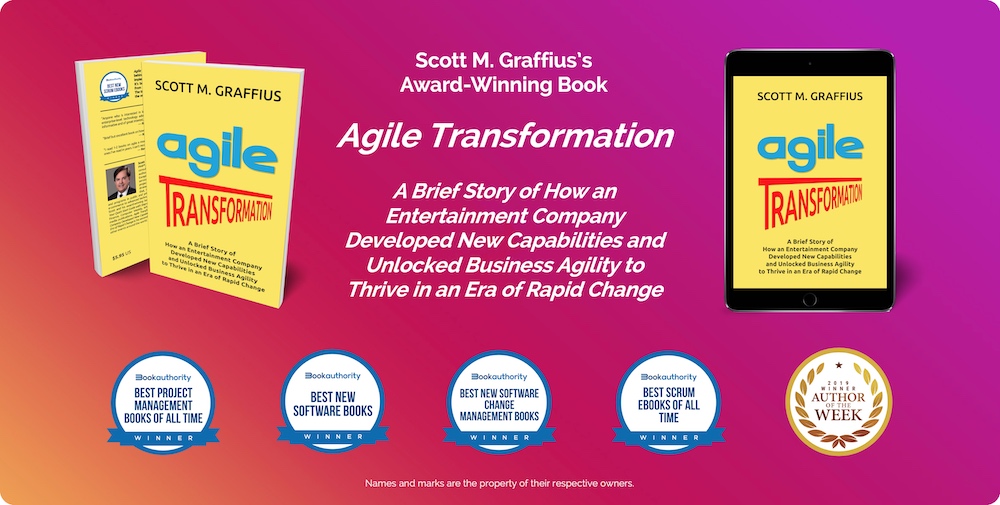
Soon after Agile Transformation: A Brief Story of How an Entertainment Company Developed New Capabilities and Unlocked Business Agility to Thrive in an Era of Rapid Change was released earlier this year, BookAuthority named the ebook/Kindle format of the publication a winner in multiple categories, including Best Scrum Ebooks of All Time. Agile Transformation is also available in print, and BookAuthority recently honored the paperback as a winner in multiple categories, including Best Project Management Books of All Time. Thank you to BookAuthority for the recognition! The short (30-second) trailer for the book was updated to highlight the two awards listed above. Details and the refreshed trailer are available here: https://www.facebook.com/AgileTransformationBook/videos/450537145587506/. You’re invited to check them out.


About Author Scott M. Graffius

Scott M. Graffius, CSP-SM, CSP-PO, CSM, CSPO, PMP, ITIL, LSSGB is a project management expert, consultant, speaker, and author. He is a Principal Consultant and the CEO of Exceptional PPM and PMO Solutions™, a professional services firm, where he helps clients strengthen their project management capabilities and realize their strategic objectives and business initiatives. Before that, he ran and supervised the delivery of projects and programs in public and private companies with businesses ranging from e-commerce to advanced technology, manufacturing, entertainment, and more. Scott and his award-winning book on agile project management, Agile Scrum: Your Quick Start Guide with Step-by-Step Instructions, have been featured in Yahoo Finance, the Boston Herald, Learning Solutions, Informa, Innovation Management, and additional media publications. His second title, Agile Transformation: A Brief Story of How an Entertainment Company Developed New Capabilities and Unlocked Business Agility to Thrive in an Era of Rapid Change, was published in April 2019. BookAuthority named it one of the best new books on Scrum. Scott regularly speaks at conferences and other events around the world.
His full bio is available here.
Connect with Scott on:
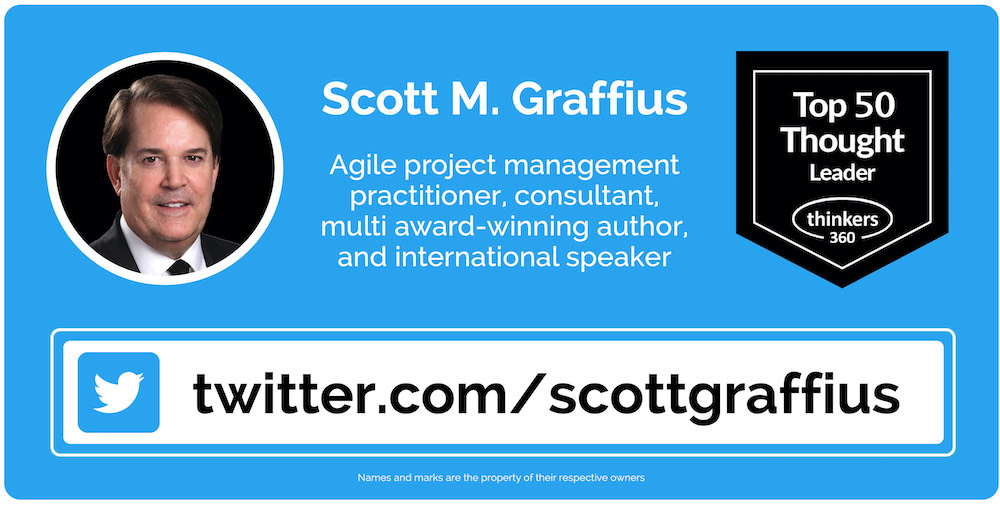

About Agile Scrum: Your Quick Start Guide with Step-by-Step Instructions
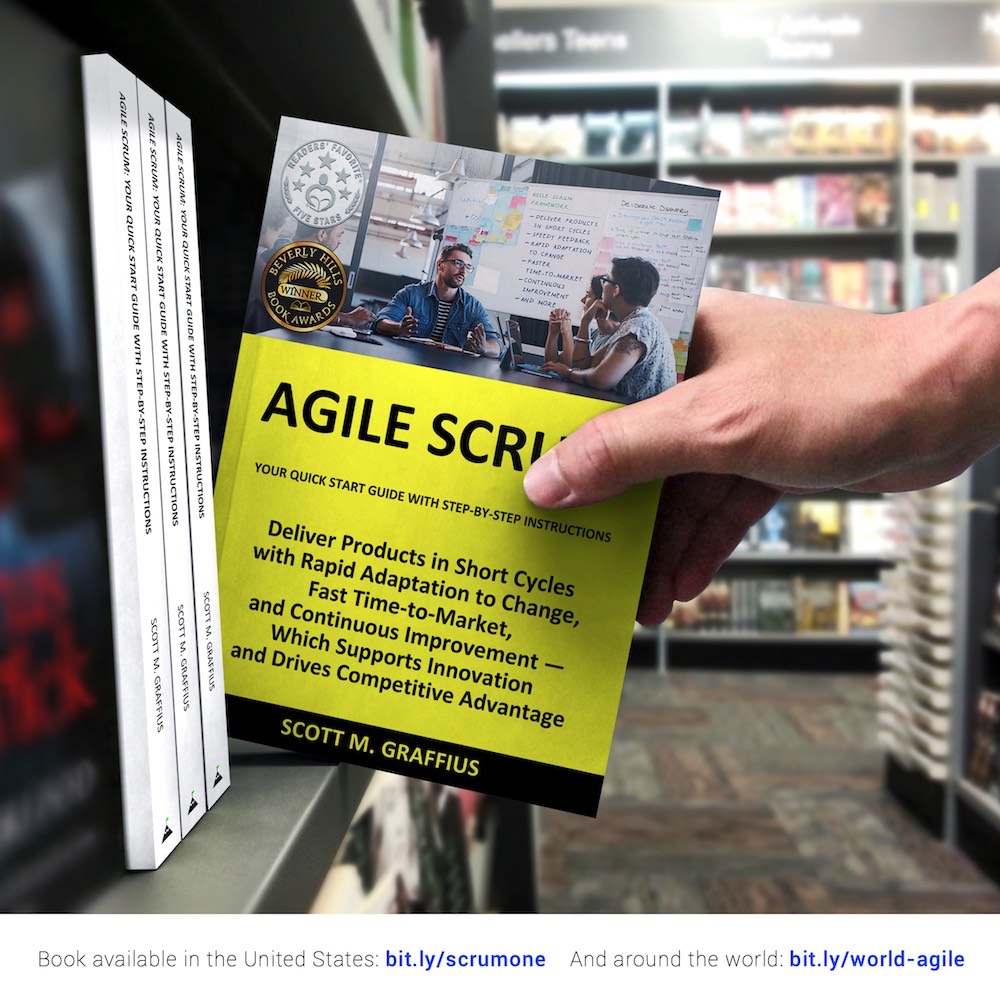
Shifting customer needs are common in today's marketplace. Businesses must be adaptive and responsive to change while delivering an exceptional customer experience to be competitive.
There are a variety of frameworks supporting the development of products and services, and most approaches fall into one of two broad categories: traditional or agile. Traditional practices such as waterfall engage sequential development, while agile involves iterative and incremental deliverables. Organizations are increasingly embracing agile to manage projects, and best meet their business needs of rapid response to change, fast delivery speed, and more.
With clear and easy to follow step-by-step instructions, Scott M. Graffius's award-winning Agile Scrum: Your Quick Start Guide with Step-by-Step Instructions helps the reader:
Hailed by Literary Titan as “the book highlights the versatility of Scrum beautifully.”
Winner of 17 first place awards.
Agile Scrum: Your Quick Start Guide with Step-by-Step Instructions is available in paperback and ebook/Kindle in the United States and around the world. Some links by country follow.

About Agile Transformation: A Brief Story of How an Entertainment Company Developed New Capabilities and Unlocked Business Agility to Thrive in an Era of Rapid Change
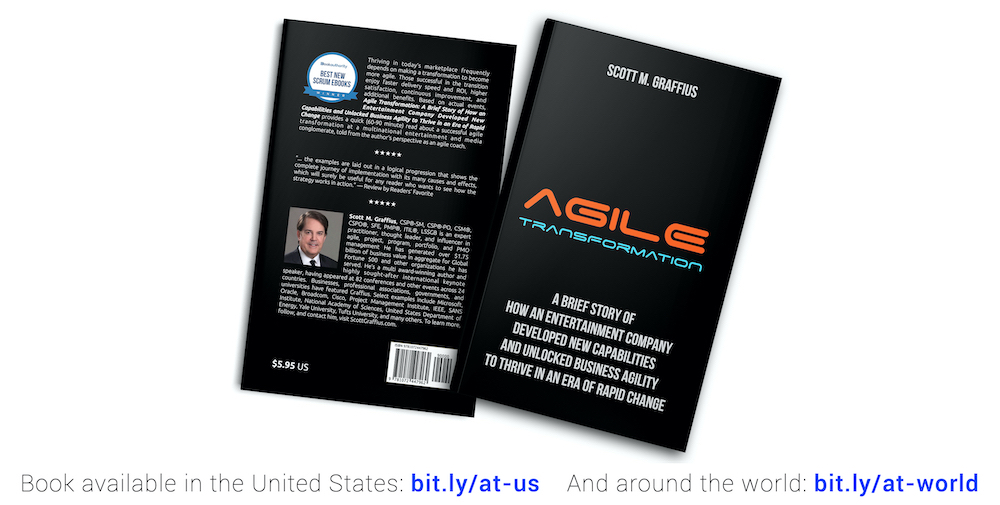
Thriving in today's marketplace frequently depends on making a transformation to become more agile. Those successful in the transition enjoy faster delivery speed and ROI, higher satisfaction, continuous improvement, and additional benefits.
Based on actual events, Agile Transformation: A Brief Story of How an Entertainment Company Developed New Capabilities and Unlocked Business Agility to Thrive in an Era of Rapid Change provides a quick (60-90 minute) read about a successful agile transformation at a multinational entertainment and media company, told from the author's perspective as an agile coach.
The award-winning book by Scott M. Graffius is available in paperback and ebook/Kindle in the United States and around the world. Some links by country follow.

About BookAuthority
BookAuthority curates the books recommended by the world's most successful CEOs, business leaders, and domain experts such as Elon Musk, Warren Buffett, Sheryl Sandberg, and David Allen. Only the very best books are featured on BookAuthority. To keep BookAuthority's site objective and unbiased, ratings are calculated purely based on data. BookAuthority uses a proprietary technology to identify and rate the best nonfiction books, using dozens of different signals, including public mentions, recommendations, ratings, sentiment, popularity and sales history. BookAuthority does not accept requests to feature books, nor does BookAuthority conduct business with publishers or authors. BookAuthority has been featured on CNN, Forbes and Inc. The preceding information is based on content from BookAuthority.org.

© Copyright 2019 Scott M. Graffius. All rights reserved. This material may not be published, broadcast, rewritten or redistributed without the express written permission of Scott M. Graffius.


Soon after Agile Transformation: A Brief Story of How an Entertainment Company Developed New Capabilities and Unlocked Business Agility to Thrive in an Era of Rapid Change was released earlier this year, BookAuthority named the ebook/Kindle format of the publication a winner in multiple categories, including Best Scrum Ebooks of All Time. Agile Transformation is also available in print, and BookAuthority recently honored the paperback as a winner in multiple categories, including Best Project Management Books of All Time. Thank you to BookAuthority for the recognition! The short (30-second) trailer for the book was updated to highlight the two awards listed above. Details and the refreshed trailer are available here: https://www.facebook.com/AgileTransformationBook/videos/450537145587506/. You’re invited to check them out.

About Author Scott M. Graffius

Scott M. Graffius, CSP-SM, CSP-PO, CSM, CSPO, PMP, ITIL, LSSGB is a project management expert, consultant, speaker, and author. He is a Principal Consultant and the CEO of Exceptional PPM and PMO Solutions™, a professional services firm, where he helps clients strengthen their project management capabilities and realize their strategic objectives and business initiatives. Before that, he ran and supervised the delivery of projects and programs in public and private companies with businesses ranging from e-commerce to advanced technology, manufacturing, entertainment, and more. Scott and his award-winning book on agile project management, Agile Scrum: Your Quick Start Guide with Step-by-Step Instructions, have been featured in Yahoo Finance, the Boston Herald, Learning Solutions, Informa, Innovation Management, and additional media publications. His second title, Agile Transformation: A Brief Story of How an Entertainment Company Developed New Capabilities and Unlocked Business Agility to Thrive in an Era of Rapid Change, was published in April 2019. BookAuthority named it one of the best new books on Scrum. Scott regularly speaks at conferences and other events around the world.
His full bio is available here.
Connect with Scott on:


About Agile Scrum: Your Quick Start Guide with Step-by-Step Instructions

Shifting customer needs are common in today's marketplace. Businesses must be adaptive and responsive to change while delivering an exceptional customer experience to be competitive.
There are a variety of frameworks supporting the development of products and services, and most approaches fall into one of two broad categories: traditional or agile. Traditional practices such as waterfall engage sequential development, while agile involves iterative and incremental deliverables. Organizations are increasingly embracing agile to manage projects, and best meet their business needs of rapid response to change, fast delivery speed, and more.
With clear and easy to follow step-by-step instructions, Scott M. Graffius's award-winning Agile Scrum: Your Quick Start Guide with Step-by-Step Instructions helps the reader:
- Implement and use the most popular agile framework―Scrum;
- Deliver products in short cycles with rapid adaptation to change, fast time-to-market, and continuous improvement; and
- Support innovation and drive competitive advantage.
Hailed by Literary Titan as “the book highlights the versatility of Scrum beautifully.”
Winner of 17 first place awards.
Agile Scrum: Your Quick Start Guide with Step-by-Step Instructions is available in paperback and ebook/Kindle in the United States and around the world. Some links by country follow.
- 🇧🇷 Brazil
- 🇨🇦 Canada
- 🇨🇿 Czech Republic
- 🇩🇰 Denmark
- 🇫🇮 Finland
- 🇫🇷 France
- 🇩🇪 Germany
- 🇬🇷 Greece
- 🇭🇺 Hungary
- 🇮🇳 India
- 🇮🇪 Ireland
- 🇮🇱 Israel
- 🇮🇹 Italy
- 🇯🇵 Japan
- 🇱🇺 Luxembourg
- 🇲🇽 Mexico
- 🇳🇱 Netherlands
- 🇳🇿 New Zealand
- 🇳🇴 Norway
- 🇪🇸 Spain
- 🇸🇪 Sweden
- 🇨🇭 Switzerland
- 🇦🇪 UAE
- 🇬🇧 United Kingdom
- 🇺🇸 United States

About Agile Transformation: A Brief Story of How an Entertainment Company Developed New Capabilities and Unlocked Business Agility to Thrive in an Era of Rapid Change

Thriving in today's marketplace frequently depends on making a transformation to become more agile. Those successful in the transition enjoy faster delivery speed and ROI, higher satisfaction, continuous improvement, and additional benefits.
Based on actual events, Agile Transformation: A Brief Story of How an Entertainment Company Developed New Capabilities and Unlocked Business Agility to Thrive in an Era of Rapid Change provides a quick (60-90 minute) read about a successful agile transformation at a multinational entertainment and media company, told from the author's perspective as an agile coach.
The award-winning book by Scott M. Graffius is available in paperback and ebook/Kindle in the United States and around the world. Some links by country follow.
- 🇦🇺 Australia
- 🇦🇹 Austria
- 🇧🇷 Brazil
- 🇨🇦 Canada
- 🇨🇿 Czech Republic
- 🇩🇰 Denmark
- 🇫🇮 Finland
- 🇫🇷 France
- 🇩🇪 Germany
- 🇬🇷 Greece
- 🇮🇳 India
- 🇮🇪 Ireland
- 🇯🇵 Japan
- 🇱🇺 Luxembourg
- 🇲🇽 Mexico
- 🇳🇱 Netherlands
- 🇳🇿 New Zealand
- 🇪🇸 Spain
- 🇸🇪 Sweden
- 🇨🇭 Switzerland
- 🇦🇪 United Arab Emirates
- 🇬🇧 United Kingdom
- 🇺🇸 United States

About BookAuthority
BookAuthority curates the books recommended by the world's most successful CEOs, business leaders, and domain experts such as Elon Musk, Warren Buffett, Sheryl Sandberg, and David Allen. Only the very best books are featured on BookAuthority. To keep BookAuthority's site objective and unbiased, ratings are calculated purely based on data. BookAuthority uses a proprietary technology to identify and rate the best nonfiction books, using dozens of different signals, including public mentions, recommendations, ratings, sentiment, popularity and sales history. BookAuthority does not accept requests to feature books, nor does BookAuthority conduct business with publishers or authors. BookAuthority has been featured on CNN, Forbes and Inc. The preceding information is based on content from BookAuthority.org.

© Copyright 2019 Scott M. Graffius. All rights reserved. This material may not be published, broadcast, rewritten or redistributed without the express written permission of Scott M. Graffius.

